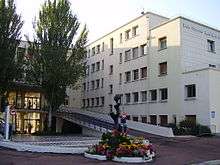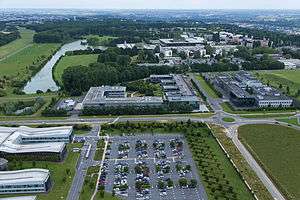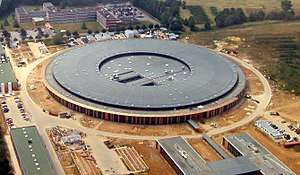University of Paris-Saclay
|
Université Paris-Saclay | |
|
| |
| Established | December 29, 2014[1] |
|---|---|
| President | Gilles Bloch[2] |
Academic staff | 10,500[3] |
| Students | 60,000[3] |
| Postgraduates | 23,300 |
| 6,000 | |
| Location |
Paris, Versailles, Saint-Quentin-en-Yvelines, Saint-Aubin, France 48°42′42″N 2°10′17″E / 48.7117343°N 2.1712888°ECoordinates: 48°42′42″N 2°10′17″E / 48.7117343°N 2.1712888°E |
| Campus | Paris-Saclay, Versailles Saint-Quentin-en-Yvelines, Université Paris-Sud |
| Website | universite-paris-saclay.fr |
The University of Paris-Saclay (French: Université Paris-Saclay) is a French federal research university system which is currently under development. It is part of the Paris-Saclay project, which is a research-intensive academic campus and business cluster being developed on the Plateau de Saclay near Paris, and is expected to become the main center for training and research within the technology cluster of Paris-Saclay, similar to Stanford University in the Silicon Valley and the Technion – Israel Institute of Technology in Israel.[4][5]
With the aim to become a world top-10 university, the University of Paris-Saclay integrates several leading grandes écoles, public universities, and research centers that are part of the world's top research organizations in various fields.[6][7]
The University System's first academic year started in September 2015.[8]
Establishment
The University of Paris-Saclay was established in 2015, with the aim to become a top-ranking, research-focused French federal university. In order to be recognized as an entity of sufficient size and quality, the university regroups some of the top grandes écoles in France with public universities under a single campus on the Saclay Plateau. Each member institution will remain independent but share a significant portion of existing and newly invested resources. This follows a model similar to the one adopted by University of Oxford or Cambridge, where each constituent college keeps its independence, while being grouped under a 'university'.[5]
According to Dominique Vernay, chairman of the foundation developing Paris-Saclay, the university aims at a top-10 position in the Academic Ranking of World Universities (ARWU), but "the first goal is to be the top university in continental Europe".[6]
Furthermore, the university aims to contribute to maximizing the economic and business potential of the Paris-Saclay project through research, via university and research spin-offs, as well as industrial research collaboration with established companies.[9]
Setup
The University of Paris-Saclay plans to combine resources from the following French universities and grandes écoles, as well as partial resources from various research organizations and the Systematic Paris-Region cluster:[9]
Universities
| Name | Foundation[10] | Field | Students |
|---|---|---|---|
| University of Paris-Sud | 1151/1971 | Science, medicine, economy and law | 27,307 |
| Versailles Saint-Quentin-en-Yvelines University | 1991 | Science, social science and life science | 19,000 |
| University of Évry Val d'Essonne | 1991 | Science, social science and life science | 10,500 |
Grandes Écoles
| Name | Foundation[10] | Field | Students |
|---|---|---|---|
| AgroParisTech | 1826 | Life sciences | 2,420 |
| CentraleSupélec (École Centrale Paris and Supélec) | 1829, 1894 | Science and engineering | 4,480 (2,505 and 1,975) |
| ENS Paris-Saclay | 1892 | Science | 1,360 |
| École Polytechnique | 1794 | Science and engineering | 3,011 |
| Institut d'optique Graduate School | 1917 | Optics | 440 |
| ENSAE ParisTech | 1942 | Economics and statistics | 423 |
| ENSTA ParisTech | 1741 | Engineering | 981 |
| HEC Paris | 1881 | Business | 4,000 |
| Institut Mines-Télécom (Télécom ParisTech and Télécom SudParis) | 1878, 1979 | ICT | 2,437 (1,400 and 1,037) |
Research organizations
The following research organizations have established research centers within the University of Paris-Saclay. The resources contributed by these organizations will remain largely independent from other member institutions. Once the University of Paris-Saclay is fully integrated, its research centers are expected to achieve a profile similar to the Jet Propulsion Laboratory of Caltech:
- CEA (Atomic Energy and Alternative Energies Commission)
- CNRS (French National Centre for Scientific Research)
- Inria (French Institute for Research in Computer Science and Automation)
- INSERM (French Institute of Health and Medical Research)
- Institut des Hautes Études Scientifiques (Institute of Advanced Scientific Studies)
- INRA (French National Institute for Agricultural Sciences)
- ONERA (National Board of Study and Aerospace Research)
- SOLEIL (a synchrotron facility)
Academic programs
Each member school of the University of Paris-Saclay organizes training in a given scientific field. Depending on the needs of their registered program, a student enrolled in a particular school will have access to academic resources from other schools.
The various fields of study available at University of Paris-Saclay are broadly categorized into the following:
- Biodiversity, Agriculture and Food, Society, Environment (Biodiversité, Agriculture Et Alimentation, Société, Environnement) ;
- Biology, Medicine, Pharmaceutical studies (Biologie, Médecine, Pharmacie) ;
- Law, Political Science (Droit Et Science Politique) ;
- Humanities (Humanités) ;
- Engineering, Sciences and Information Technologies (Ingénierie, Sciences Et Technologies De L’information) ;
- Sport and Human Motion Sciences (Sciences Du Sport Et Du Mouvement Humain) ;
- Basic Sciences(Sciences Fondamentales) ;
- Social Sciences (Sciences Sociales).
The academic programs in each of the 8 schools is expected to follow the Anglo-American model:[11]
- Bachelor - The Bachelor's program is provided by the 3 public universities within Paris-Saclay, which are Université Paris-Sud, Université Versailles-Saint-Quentin and Université d'Évry Val-d'Essonne.
- Master - Master's degrees are taught in both French and English. Altogether, 49 Master's degree will be offered.[12]
- Doctorate - PhD programs are offered through 20 doctoral schools.[8] Doctoral degrees received after September 30, 2015 are awarded under the name "University of Paris-Saclay", with a mention of the student's associated university or grande école.
Research programmes
The University of Paris-Saclay will gather more than 300 research units, organized into 10 departments:[13]
- Chemistry (Chimie)
- Electrical engineering, optics and electronics (EOE: Ingénierie électrique, optique et électronique)
- Mathematics (Mathématiques)
- Mechanics, energy and physical processes (MEP:Mécanique, énergétique et procédés)
- Subatomic physics and astrophysics (P2I: Physique des deux infinis)
- Wave and matter physics (PHOM: Physique des ondes et de la matière)
- Planetary science and cosmology (SPU: Sciences de la planète et de l'Univers)
- Life sciences (SDV: Sciences de la Vie)
- Human and social sciences (SHS: Sciences de l'Homme et de la Société)
- Information and communication sciences and technologies (STIC: Sciences et technologies de l'information et de la communication).
University rankings
The university is still under its integrative process and has yet to officially appear in international rankings. However, in an independent simulation performed by the Academic Ranking of World Universities (ARWU) in 2014, the University of Paris-Saclay scored 39.8 (or 43.2 if all Research Organizations are counted), ranking the university in the 27th position (resp. 21st).[14] On October 19, 2016, the executive director responsible for the annual update and new development of the ARWU visited the Paris-Saclay cluster.[15]
In the future, the Paris-Saclay cluster is expected to help France to secure a space amongst the world's Top-10 universities and to bring the French education and research into limelight.[5]
See also
References
- ↑ "Establishment of Université Paris-Saclay «Décret n° 2014-1674 du 29 décembre 2014»". legifrance.gouv.fr. Retrieved 29 May 2016.
- ↑ "Gilles Bloch elected President of Université Paris-Saclay". universite-paris-saclay.fr. Retrieved 29 May 2016.
- 1 2 "A World Class University". epps.fr. Archived from the original on 2015-09-24. Retrieved 2016-11-06.
- ↑ Université Paris-Sud / Zee Agency. "Paris-Sud University is part of Paris-Saclay's project - Université Paris-Sud". u-psud.fr.
- 1 2 3 "France plans elite top-10 mega-university". BBC.com. Retrieved 29 May 2016.
- 1 2 Staley, Oliver (13 March 2014). "Nations Chasing Harvard Merge Colleges to Ascend Rankings". bloomberg.com. Retrieved 13 March 2014.
- ↑ Nic Mitchell "Big is beautiful for merging universities",BBC News,25 November 2015
- 1 2 "Creation of University of Paris-Saclay". Universite Paris Sud/.
- 1 2 "Towards Université Paris-Saclay". www.campus-paris-saclay.fr. Archived from the original on 4 June 2014. Retrieved 15 March 2013.
- 1 2 Foundation of the oldest constituent part of the school
- ↑ "Foundation of University of Paris-Saclay" (PDF). Universite Paris Sud/.
- ↑ "Masters Programs at Paris-Saclay". Universite-paris-saclay.fr/.
- ↑ "Various Labs at Paris-Saclay". Universite-paris-saclay.fr/.
- ↑ "Les COMUE et le classement de Shanghai ARWU 2014" (PDF). Retrieved 21 Sep 2016.
- ↑ "Visit of the Executive Director of the "Shanghai Ranking" at the Université Paris-Saclay | Université Paris Saclay". www.universite-paris-saclay.fr. Retrieved 2016-10-31.
External links
| Wikimedia Commons has media related to University of Paris-Saclay. |






